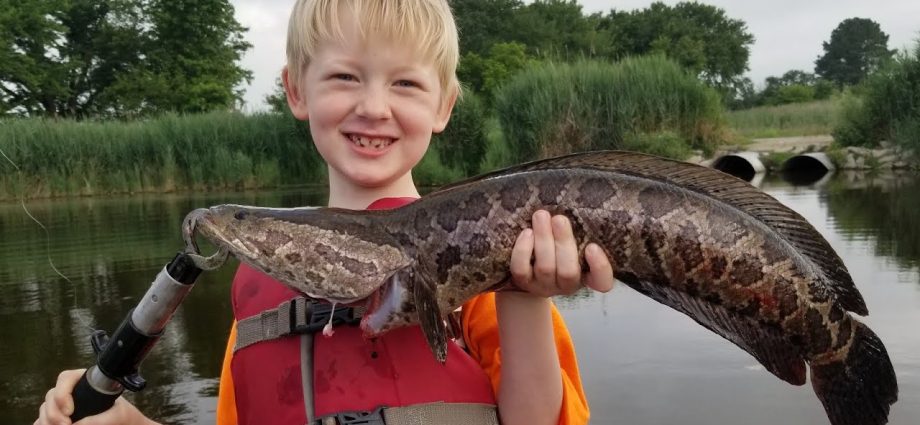Contents
Snakehead habitats, fishing methods and effective baits
The snakehead is a fish with a recognizable appearance. In Russia, it is an indigenous inhabitant of the Amur River basin, in the lower reaches. Lives in warm waters. Differs in the ability to easily tolerate oxygen deficiency in water. In case of drying up of the reservoir, it can move on land with the help of fins for a long time and over fairly long distances. A very aggressive fish, during the period of spawning and maturation of the larvae, the males build and guard the nest, while they can attack everyone who approaches, regardless of the size of the “enemy”. It is an active predator, but can also feed on dead fish. The main method of hunting: an ambush attack, in case of living in reservoirs with open spaces, “patrols” small places and the coastline. The presence of a predator is easily detected by bubbles on the surface of the water and noisy attacks in shallow water. There are several subspecies and slight color variation. The size of the fish can reach almost 1 meter in length and weigh more than 8 kg.
Methods for catching snakehead
The most popular way to catch snakehead is spinning. In its natural environment, it prefers areas of reservoirs with shallow waters, snags and overgrown with aquatic vegetation. From the point of view of biting, the fish is quite “capricious” and cautious. Snakehead can be fished with floats, using live bait or dead fish as bait.
Catching a snakehead on spinning
Spinning fishing has several features. This is due to the living conditions of the snakehead and some habits. It is worth noting here that the choice of gear should be approached from the point of view of fishing for very impulsive fish. The main criteria for choosing a rod in modern spinning fishing is the fishing method. In our case, for the most part, this is fishing on surface baits. Length, action and test are chosen according to the place of fishing, personal preferences and baits used. In the case of fishing in the overgrown reservoirs of Primorye, fishing usually takes place from a boat. There is no need to use a long rod, so a length of up to 2.40 m is enough. An important factor for catching a snakehead is a confident hook, rods with a “fast action” are more suitable for this, but do not forget that rods with a “medium” or “medium-fast ”, “forgive” much more mistakes when fighting. It is advisable to purchase reels and cords, respectively, for the selected rod. If you choose a short, “fast” rod, take the reel more seriously, in particular in terms of the features of the drag. It should not only be reliable when fighting very impulsive fish, but would allow you to regulate the descent of the line, in the event of a long fight in thickets of aquatic vegetation. With the help of spinning, in open areas of the reservoir, the snakehead can be caught on tackle with a dead fish.
Catching a snakehead with a float rod
The fish were introduced into various reservoirs. In the case of fishing in snakehead breeding areas on artificial reservoirs, where there are no natural ambushes or there are few of them, you can try to fish with float rods. To do this, it is more convenient to use rods with a “running snap”. With a long rod and reel, it is much easier to stop a fast-moving fish. The fishing lines are used thick enough, the floats must be with a large “carrying capacity” in order to hold the “live bait” or dead fish. If possible, casts are made to the points of possible accumulation of a fattening predator: snag, reed thickets, etc.; in the absence of all these conditions, near the shore edge, where snakeheads come to feed. When fishing for a dead fish, sometimes it is worth doing light “pulls”, but you need to keep in mind that the snakehead fish is very cautious and stops hunting in case of any danger.
Baits
For catching snakehead on spinning rods, a large number of different surface lures are used. Recently, various volumetric “non-hooks” – frogs – have been especially popular. Depending on the reservoir, fish are caught on wobblers, lures equipped with propellers and spinners.
Places of fishing and habitat
As already mentioned, on the territory of Russia, in addition to the Amur basin, snakeheads are bred in several regions of Central Russia, as well as in Siberia. Lives in Central Asia. Given the heat-loving nature of the species, regions with a warm climate or reservoirs with artificially heated water used for heating or cooling process water are suitable for life and breeding. On the Lower Volga did not take root. Snakehead can be caught on paid farms, for example, in the Moscow region. It is introduced into the reservoirs of the Krasnodar Territory, Ukraine. The main habitats are areas covered with vegetation and underwater shelters. It is believed that in regions of natural habitation, with cold winters, snakeheads hibernate in burrows made in the clay bottom of a lake or river.
Spawning
It becomes sexually mature at the 3-4th year of life. Sometimes, under favorable conditions of existence, it also ripens on the second, with a length of more than 30 cm. Fish spawning is extended from early May to mid-summer, portioned. Fish build nests in the grass and guard them for about a month. At this time, the fish are especially aggressive. Juveniles become a full-fledged predator already at a length of 5 cm.










